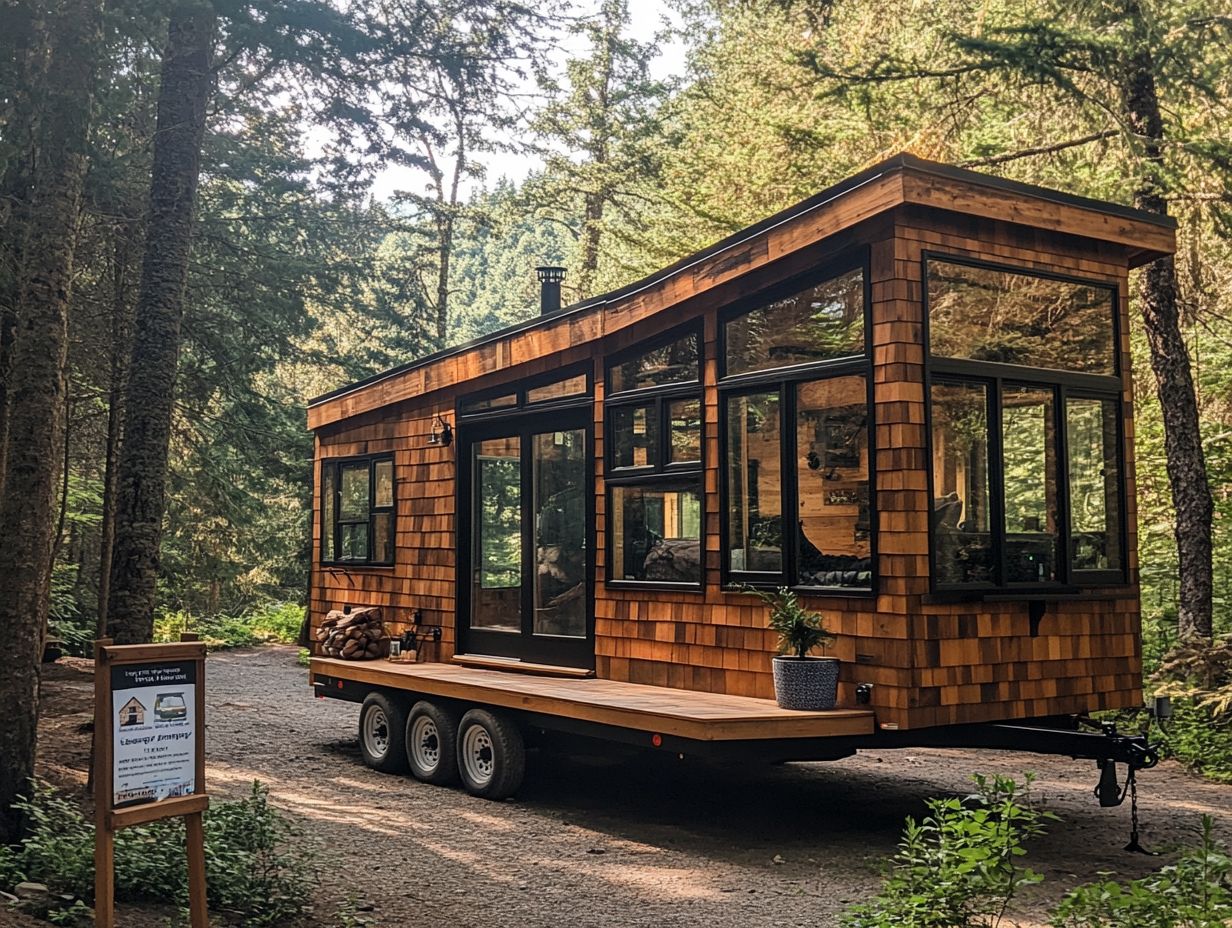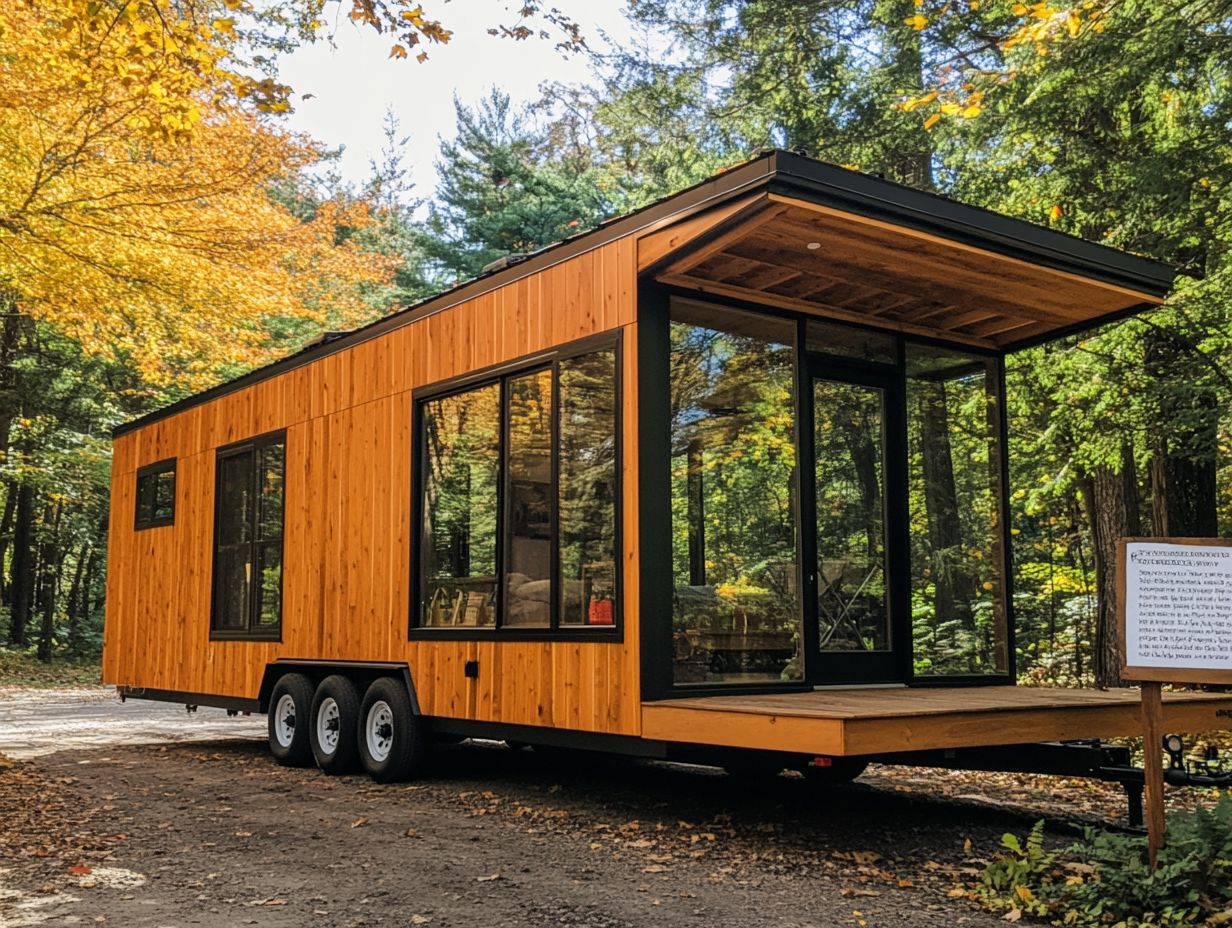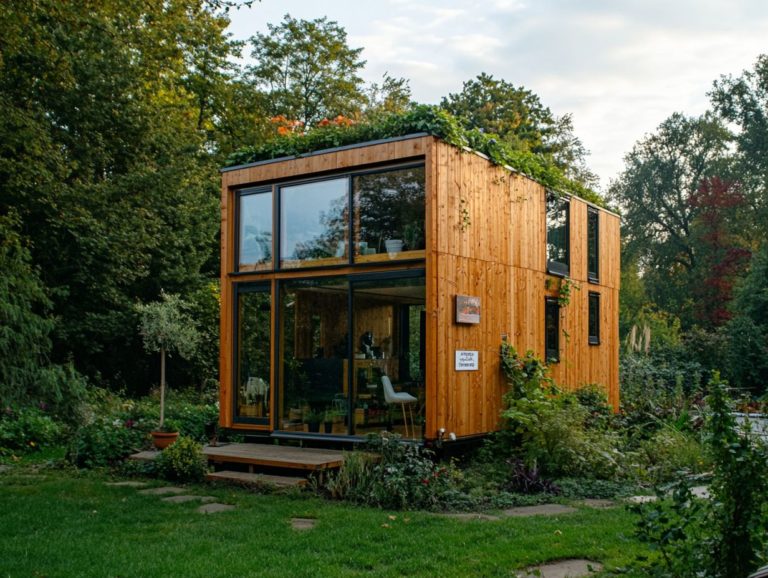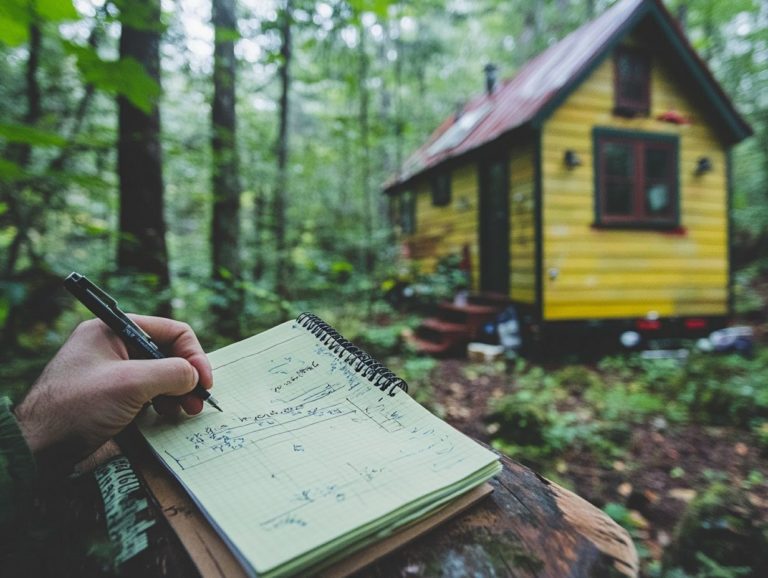Tiny House Movement and Legal Challenges
The Tiny House Movement has gained considerable traction in recent years, captivating those who crave simplicity and sustainability in their living situations. This movement encapsulates the environmental and financial benefits that come with downsizing. The rise of eco-conscious housing shows that more people are interested in sustainable living.
However, embracing tiny living does present challenges, especially regarding zoning laws and building codes. Navigating these legal hurdles requires strategic thinking. It’s essential to consider the future of the movement within an ever-evolving regulatory landscape.
Explore with us as we uncover the intricacies of tiny living and chart the path ahead for this innovative lifestyle choice. Join us on this thrilling journey to discover the many facets of tiny living!
Contents [hide]
- Key Takeaways:
- Overview of the Tiny House Movement
- Benefits of Living in a Tiny House
- Legal Challenges for Tiny House Dwellers
- Strategies for Overcoming Legal Obstacles
- Future Outlook for the Tiny House Movement
- Frequently Asked Questions
- What is the Tiny House Movement and why is it gaining popularity?
- Are there legal challenges associated with the Tiny House Movement?
- Do all states have laws for tiny houses?
- Can I legally live in a tiny house on wheels?
- Are there legal challenges facing tiny house communities?
- How can I ensure my tiny house is legally compliant?
Key Takeaways:

- The Tiny House Movement is a growing trend of living in small, efficient dwellings that promote financial and environmental benefits.
- Legal challenges for tiny house dwellers include navigating zoning and building codes, as well as permitting and land use restrictions.
- Strategies for overcoming these obstacles include seeking alternative living arrangements like tiny home communities and supporting changes in regulations with community backing.
Overview of the Tiny House Movement
The Tiny House Movement offers a compelling answer to modern housing challenges.
It presents innovative solutions rooted in sustainable practices and eco-conscious living.
By focusing on downsizing possessions and embracing minimalism, this movement advocates for tiny homes as viable alternatives that tackle the urgent issues of affordable housing and environmental sustainability.
Influential figures like Jim Greer and companies such as Clayton Homes lead the charge, championing a lifestyle that resonates with diverse communities in places like Fresno, California; Durango, Colorado; and Spur, Texas.
What is the Tiny House Movement?
The Tiny House Movement is a captivating social and architectural trend.
It focuses on maximizing living space while minimizing waste and environmental impact.
This trend often resonates with minimalists and individuals seeking more affordable housing options.
It is also appealing for veterans housing initiatives that prioritize financial independence.
This movement encourages a lifestyle of simplicity, inviting you to declutter your life and embrace a more intentional existence while utilizing a DIY approach.
By championing sustainable building practices and energy-efficient designs, tiny home advocates are making significant contributions to an eco-conscious community.
Its appeal has expanded to embrace a diverse range of people, including veterans seeking financial independence and young adults striving for a debt-free life.
Many enthusiasts of tiny living find immense value in the flexibility and mobility that smaller spaces offer.
This enables them to travel without the burdens typically associated with traditional homeownership.
The community aspect enhances this journey, fostering connections among those who share similar values and enriching the experience of living simply.
Tiny home communities have become vital in this shared experience.
Benefits of Living in a Tiny House
Embracing the tiny house lifestyle brings a wealth of benefits, from significant financial savings to a deeper commitment to environmental sustainability.
This choice resonates with individuals and families eager to streamline their lives and embrace a more minimalist approach.
It also opens avenues for financing tiny homes through options like a home equity loan or other innovative funding resources.
Environmental and Financial Advantages
Tiny homes offer compelling environmental and financial benefits. They significantly reduce both living expenses and your ecological footprint.
By embracing a minimalist approach, you ll discover that these compact dwellings not only lower your mortgage costs but also lead to impressive savings on utility bills. With less space to heat and cool, you ll consume far less energy. This financial efficiency is a major draw for those exploring tiny home living.
Tiny homes often use eco-friendly materials and efficient designs. Their construction requires fewer resources, which minimizes your overall carbon footprint. This aligns perfectly with the movement’s goal of fostering a sustainable future.
This exciting mix of saving money and caring for the planet resonates with many, making tiny homes an appealing choice for those who wish to live more consciously and affordably.
Legal Challenges for Tiny House Dwellers

While tiny homes offer many advantages, you may encounter significant legal hurdles along the way. Zoning restrictions and rigorous building codes can complicate your journey to legally inhabit these eco-friendly havens. You need to understand these legal challenges if you’re considering a tiny home.
Zoning and Building Codes
Zoning and building codes are pivotal challenges for tiny home dwellers, as these regulations dictate where and how to place and construct your home. Engaging with the local planning office can provide insights into these regulations.
These codes vary significantly from one locality to another. They can affect everything from minimum square footage requirements to the types of materials you can use for construction. In some areas, there are strict limitations on the size and design of a tiny home, which can impact your plans. It’s important to understand tiny house parking: legal guidelines to avoid potential issues and ensure your creative and sustainable aspirations are not stifled.
Local planning offices are essential in this intricate web of regulations. They interpret and enforce the rules, offering guidance on necessary permits and helping you identify zoning allowances. Additionally, they can facilitate community development discussions that might lead to more accommodating policies for tiny home communities, including insights on tiny house ownership legal rights.
By engaging with these offices, you may uncover pathways to ease some of the burdens imposed by existing codes. This collaboration can promote more flexible housing solutions that resonate with contemporary living preferences, paving the way for innovative housing trends.
Permitting and Land Use Restrictions
Permitting processes and land use restrictions present significant challenges for tiny home enthusiasts. Navigating these complex rules and processes often entails a mountain of paperwork and approvals that can stall your housing dreams. Understanding these processes is key to reaching your tiny home dream.
It can feel overwhelming, especially since each locality imposes its own set of requirements, complicating your journey toward establishing a tiny home. For instance, understanding tiny house zoning laws may categorize tiny homes as recreational vehicles, effectively barring them from being used as permanent residences in certain areas.
However, community development initiatives are emerging to dismantle these barriers. They advocate for more inclusive regulations that embrace diverse housing options like tiny home communities. Local organizations and grassroots campaigns are rallying to engage policymakers in meaningful discussions about sustainable living. They are pushing for modified zoning laws that support tiny home projects while also addressing vital infrastructure concerns, including understanding tiny house land use laws.
Strategies for Overcoming Legal Obstacles
To effectively navigate the legal challenges tied to tiny homes, you can employ a range of strategies. Consider exploring alternative living arrangements, such as RVs or tiny home communities, that align with your needs. Also, engage in advocacy and community support initiatives to bolster your position.
Alternative Living Arrangements
Alternative living arrangements, such as RVs or tiny home communities, present practical solutions for those eager to sidestep traditional housing regulations. This approach is particularly beneficial for those facing the housing crisis.
These innovative setups minimize your footprint and cultivate a sense of camaraderie among residents. By living in close quarters, tiny home enthusiasts often find themselves woven into a supportive network where neighbors share resources, skills, and experiences.
This significantly enhances your lifestyle and reinforces community ties. The flexibility of these arrangements allows you to tailor your living situation to suit your personal needs, whether you crave mobility or wish to embrace a more minimalist existence.
Embracing alternative living can open the door to a sustainable future and foster more meaningful connections within tiny home communities.
Advocacy and Community Support

Advocacy and community support are crucial in promoting the tiny house movement. They help foster greater acceptance and integration of tiny homes into local planning frameworks and housing policies. This effort is vital for removing the legal barriers often faced by tiny home owners.
These initiatives break down the legal barriers that impede the growth of tiny home communities. Grassroots campaigns and local advocates have effectively lobbied for zoning changes and rules about where certain types of homes can be built, as well as introduced legislative proposals that embrace understanding the legal status of tiny houses and other innovative housing solutions.
Engaging with organizations like the National Tiny Home Brand can bolster these initiatives. Community workshops and informational meetings serve not only to educate residents about tiny living but also facilitate meaningful dialogues between policymakers and prospective tiny home dwellers, especially regarding tiny house regulations and building practices.
Such efforts raise awareness about environmental sustainability and the role of tiny homes in addressing the housing crisis. A shining example of success is the rise of thriving tiny home villages, where collective advocacy has shifted public perception and enabled better alignment with tiny house residency laws you should know.
This ultimately paves the way for more sustainable living options and ensures that the vision of the tiny house movement continues to expand across the United States.
Future Outlook for the Tiny House Movement
The future of the Tiny House Movement looks quite promising, with potential solutions and regulatory changes on the horizon. These developments aim to address the ongoing housing crisis while fostering greater acceptance of tiny homes.
By remaining engaged with advocacy efforts, you can play a role in shaping the trajectory of sustainable housing solutions.
Potential Solutions and Changes in Regulations
Potential solutions and changes in regulations are crucial for fostering the growth of tiny homes. They encourage creative zoning approaches and community development initiatives that embrace these innovative living solutions.
As urban areas face the challenges of rising housing costs and limited space, inclusive policy adjustments are being proposed to accommodate tiny house communities. These recommendations aim to streamline permitting processes, making construction and occupancy easier, while also addressing understanding tiny house regulations in urban areas.
Local governments are even exploring incentives like tax breaks or grants for developers who integrate tiny homes into their projects. These measures tackle the housing crisis and promote sustainable living practices while fostering a sense of belonging within neighborhoods.
By embracing the tiny house movement, you can help cultivate diversity and resilience, paving the way for a more affordable and cohesive housing landscape.
Now is the time to join the tiny house movement! Get involved, advocate for change, and help shape a sustainable future for housing!
Frequently Asked Questions
What is the Tiny House Movement and why is it gaining popularity?
The Tiny House Movement encourages living in smaller, efficient homes. It s gaining popularity due to rising housing costs and a desire for a minimalist, sustainable lifestyle.
Are there legal challenges associated with the Tiny House Movement?

Yes, there are several legal challenges. These include getting permits, zoning approvals (rules about how land can be used), and meeting building codes.
Do all states have laws for tiny houses?
No, not all states have specific laws for tiny houses. However, many local governments are starting to create guidelines for legal tiny house living.
Can I legally live in a tiny house on wheels?
It depends on state and local laws. Some places allow permanent dwellings on wheels, while others only permit temporary use. Be sure to research your local regulations.
Are there legal challenges facing tiny house communities?
Yes, tiny house communities face challenges like land use issues, obtaining necessary permits, and potential conflicts with neighbors or local regulations.
How can I ensure my tiny house is legally compliant?
To make sure your tiny house is legal, research the building codes and regulations in your area. Consulting with a lawyer or local officials can also be very helpful.






